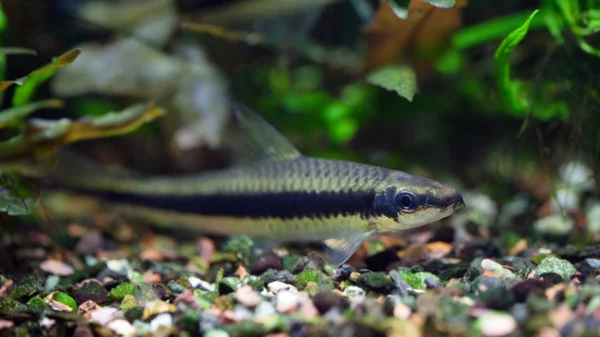Fish names that start with f are numerous. They include false bumblebee catfish, feather barbel catfish, filament tetra, etc.
Some are saltwater fish that live deep in the salty seas or stay within coral reefs. Others are freshwater fish that love well-planted freshwaters and easy-flowing rivers.
Their common names may not sound anything like their scientific names, and that is why you need to know everything about your pets.
Check out our list of fish names that start with the letter F. You can start by checking out our top 5 fish names beginning with the letter F.
Our Top 5 Fish Names Beginning With Letter F
Fire Eels (Mastacembelus erythrotaenia)
This is one of our best picks that start with F, and it is a relatively large species of spiny eels. It is endemic to freshwaters of southeast Asia, but it is also one of the much-traded pets in the aquarium hobby.

Unlike true electric eels, this spiny fish is not a true eel. It is a fish with an elongated body and a fine pointed snout. It has a compact body that flattens into the caudal fin to form an extended tail fin. Fire eels have a base color of dark brown or grey with a lighter color variation for the underbelly.
It is the largest fish species in the Mastacembelidae family. It can grow up to 39.6 inches. It is usually housed in larger aquariums, and it does well in a well-planted community tank, as it is an omnivore. Their food in the wild includes plant matter, insect larvae, small crustaceans, etc. They also eat smaller fish.
But you do not want to pair them with other bottom dwellers like the fighting loach as they tend to be aggressive to smaller tankmates.
Flying Fox (Epalzeorhynchus kallopterus)
This is a southeast Asian cyprinid commonly kept as a pet in the hobby. It is an ornamental fish and is a prolific omnivore. It is usually known as an algae eater and is often mistaken for the Siamese algae eater.

Flying foxes can grow up to 6 inches but are frequent victims of stunting in aquariums. Their average length in the aquarium is 4 inches. They are bottom dwellers and will do well in an adequately lit tank as they forage for algae. You also want to use gravel for the substrate.
They are compatible with many other fish but may become territorial against their kind if you keep a group in a fish tank.
Fairy Cichlids (Neolamprologus brichardi)
Lyretail cichlid is another common name for this beautiful fish. Many other aquarists may refer to it as Princess Cichlid, Princess of Burundi, and Brichard’s lamprologus. Fairy cichlids are beautiful fish indeed, but they do not have wings or the magical powers of fairies.

Fairy cichlid belongs to the Neolamphrologus genus, which is endemic to the hard waters of the Lake Tanganyika in East Africa. It has a compact body with a long tail fin like the shape of a lyre. It usually has two dark spots beside the eyes. Unlike many smaller fish that grow only about 2 inches, lyretail cichlids grow 4 inches.
They are usually hostile and will become even more aggressive during the spawning season as they protect their eggs.
Featherfin Catfish (Synodontis eupterus)
This fish is native to the Chad Basin, the Volta and Niger Rivers, and even the basins of the White Nile.

They usually grow up to the maximum length of 12 inches, and of course, they grow barbels like normal catfish. It likes a well-planted fish tank or one with a dim light as it is a shy fish.
They like to swim at the bottom of the tank while exploring the hides and covers below. Although they are bottom dwellers, you do not want to mix your Featherfin synodontis with other aggressive pets like Malawi or Tanganyikan cichlids.
You do not also want to keep them with other predatory bottom dwellers to prevent a scenario where they become food to the larger pet fish.
Fire Goby (Nemateleotris magnifica)
This is not the least of our top picks with fish names that start with the letter F. Fire gobies are the marvel of the Indian and Pacific oceans.
They have a cool pink and somewhat yellow tail and a white head. They are fun saltwater fish, and they swim pretty fast. Some people even call them Dartfish.

You will typically find them living in burrows, either as a peaceful pair or alone. But you can find juveniles in peaceful groups. As omnivores, their food should include meat and plant matter.
Thinking about cute saltwater pets? Fire gobies are at the top of the list.
List of Fish Beginning with F
Check out the lists below:
Freshwater Fish Beginning with F
- Fairy Cichlid (Neolamprologus brichardi)
- False Bumblebee Catfish (Leiocassis stenomus)
- False Moray (Chlopsis bicolor)
- Fathead Bichir (Polypterus weeksii)
- Feather-Barbel Catfish (Opsodoras stubelii)
- Featherfin (Hemigrammus unilineatus)
- Featherfin Synodontis (Synodontis eupterus)
- Festivum (Mesonauta festivus)
- Fighting Loach (Nemacheilus notostigma)
- Filament Tetra (Bryconaethiops microstoma)
- Fingerfish (Monodactylus argenteus)
- Fire Bar Danio (Devario maetaengensis)
- Fire Eel (Mastacembelus erythrotaenia)
- Fire Stingray (Potamotrygon henlei)
- Fire Tail (Epalzeorhynchus bicolor)
- Fire-Tailed Gudgeon (Hypseleotris galii)
- Firemouth Cichlid (Thorichthys meeki)
- Five-Banded Barb (Barbus pentazona)
- Five-Bar Cichlid (Neolamprologus tretocephalus)
- Five-Spot African Cichlid (Thysochromis ansorgii)
- Flag Cichlid (Laetacara curviceps)
- Flag-Tailed Catfish (Dianema urostriata)
- Flag-Tailed Corydoras (Corydoras robineae)
- Flagfish (Jordanella floridae)
- Flagtail (Kuhliidae sandvicensis)
- Flame Tetra (Hyphessobrycon flammeus)
- Flat-Whiskered Catfish (Pinirampus pirinampu)
- Flathead Catfish (Pylodictis olivaris)
- Flier (Centrarchus macropterus)
- Florida Gar (Lepisosteus platyrhincus)
- Fly River Rainbowfish (Melanotaenia sexlineata)
- Fly-Speckled Hardyhead (Craterocephalus stercusmuscarum)
- Flying Fox (Epalzeorhynchus kallopterus)
- Forehead Brooder (Kurtus indicus)
- Fork Tailed Lamprologus (Neolamprologus furcifer)
- Four-Barred Tigerfish (Datnioides quadrifasciatus)
- Four-Eyed Fish (Anableps sp.)
- Four-Spine Cichlid (Neolamprologus tetracanthus)
- Four-Stripe Julie (Julidochromis regani)
- Freiberg’s Peacock (Aulonocara jacobfreibergi)
- Freiberg’s Peacock Cichlid (Aulonocara jacobfreibergi)
- Freidrichsthal’s Cichlid (“Cichlasoma” freidrichsthalii)
- Freshwater Barracuda (Ctenolucius hujeta)
- Freshwater Bat Fish (Myxocyprinus asiaticus)
- Freshwater Eel (Anguilla rostrata)
- Freshwater Hatchetfish (Carnegiella marthae)
- Freshwater Moray Eel (Echidna rhodochilus)
- Freshwater Ray (Potamotrygon hystrix)
- Freshwater Shark (Glyphis glyphis)
- Frogfish (Antennarius striatus)
- Frogmouth Catfish (Chaca chaca)
- Fusilier Fish (Caesionidae Family)
Saltwater Fish Beginning with F
- False Brotula (Parabrotula plagiophthalmus)
- False Cat Shark (Pseudotriakis microdon)
- False Trevally (Lactarius lactarius)
- Fangtooth (Anoplogaster cornuta)
- Fathead Sculpin (Cottunculus microps)
- Fierasfer (Carapus sp.)
- Filefish (Stephanolepis hispidus)
- Finback Cat Shark (Eridacnis radcliffei)
- Firefish (Nemateleotris decora)
- Fire Goby (Nemateleotris magnifica)
- Flabby Whale Fish (Cetomimus gillii)
- Flagblenny (Emblemaria atlantica)
- Flagfin (Latropiscis purpurissatus)
- Flashlight Fish (Anomalops katoptron)
- Flatfish (Pleuronectiformes [Order])
- Flathead (Platycephalidae [Family])
- Flounder (Paralichthys albigutta)
- Flying Fish (Parexocoetus brachypterus)
- Flying Gurnard (Dactylopterus volitans)
- Footballfish (Himantolophus groenlandicus)
- French Angelfish (Pomacanthus paru)
- Frigate Mackerel (Auxis thazard)
- Frilled Shark (Chlamydoselachus anguineus)
Related:

